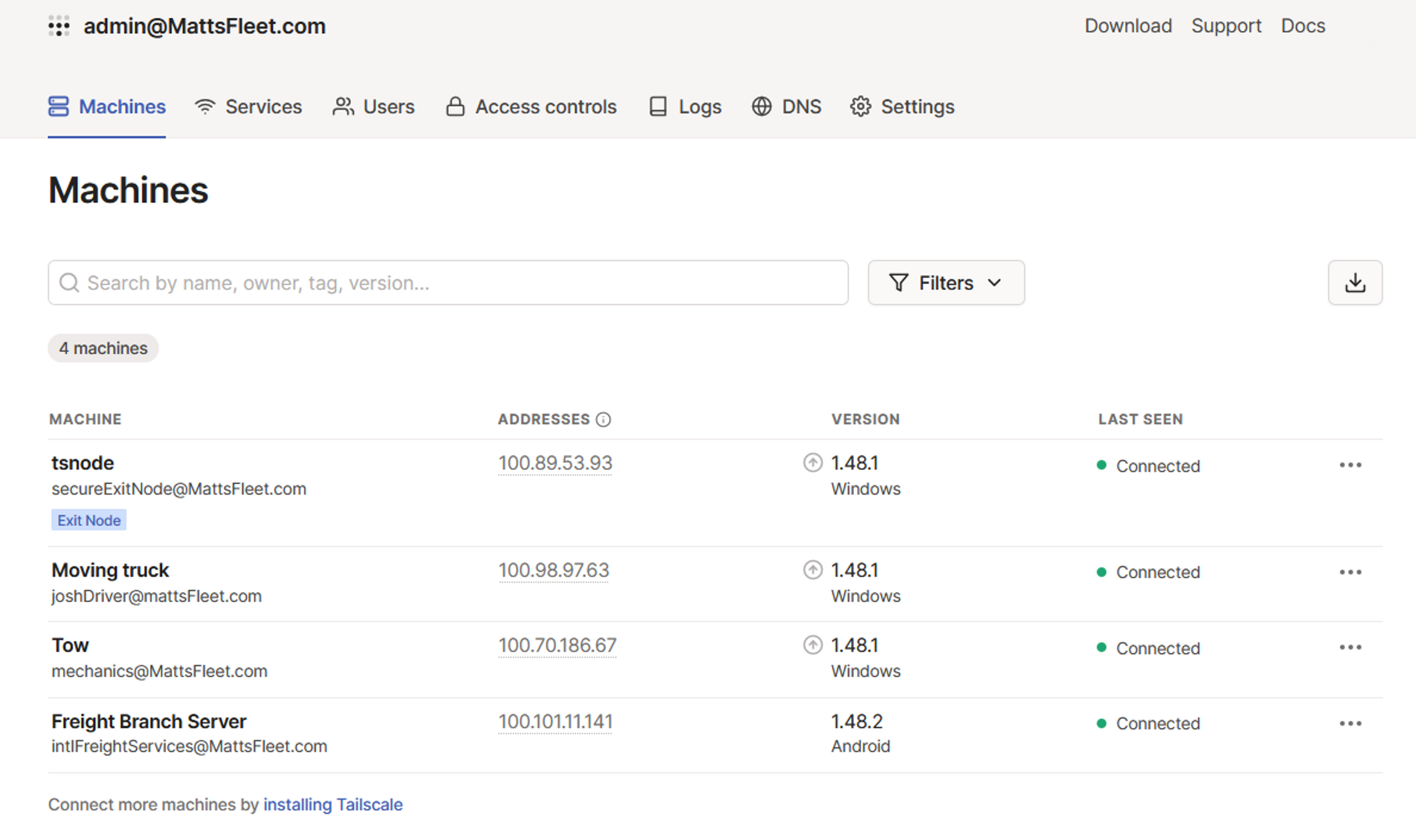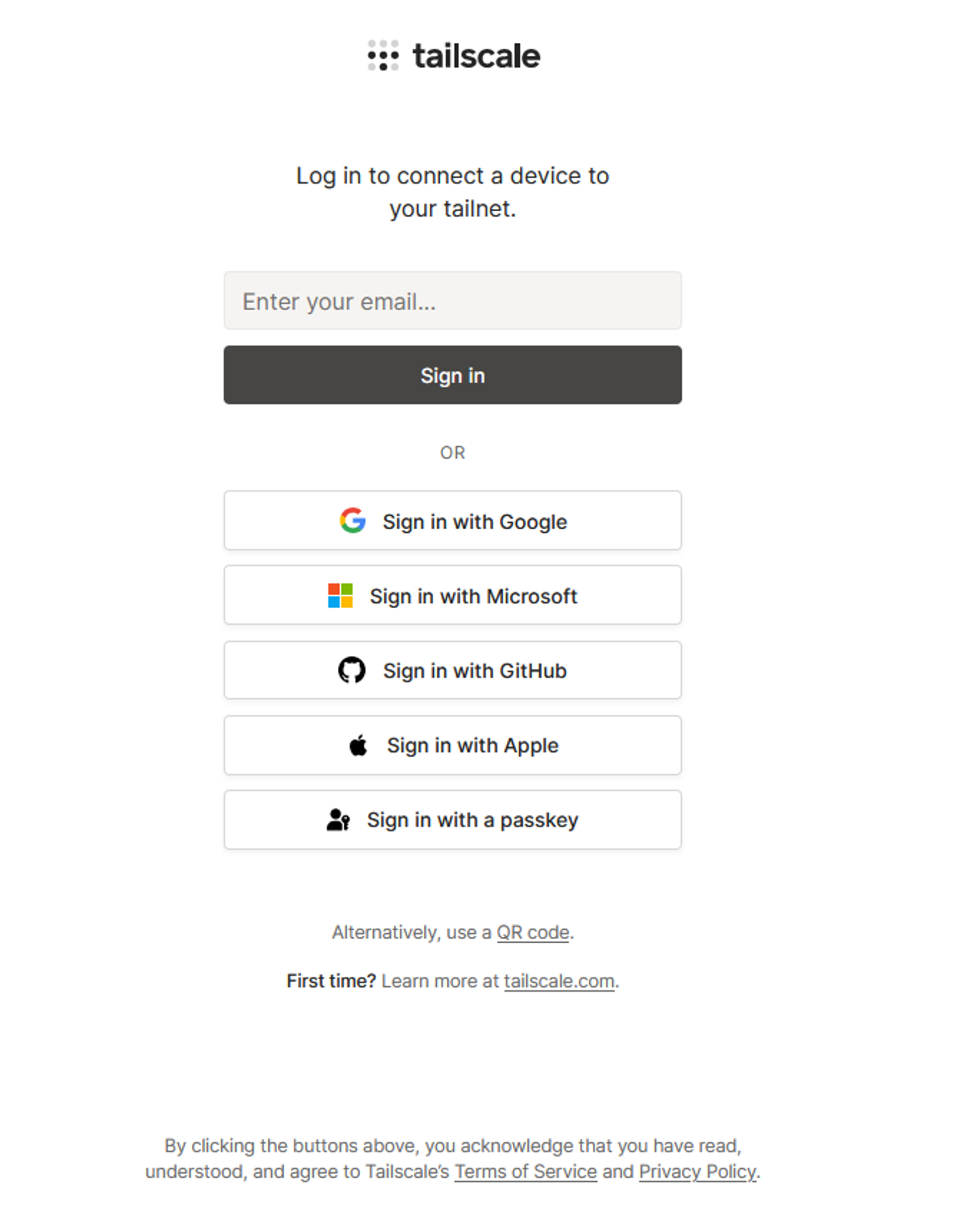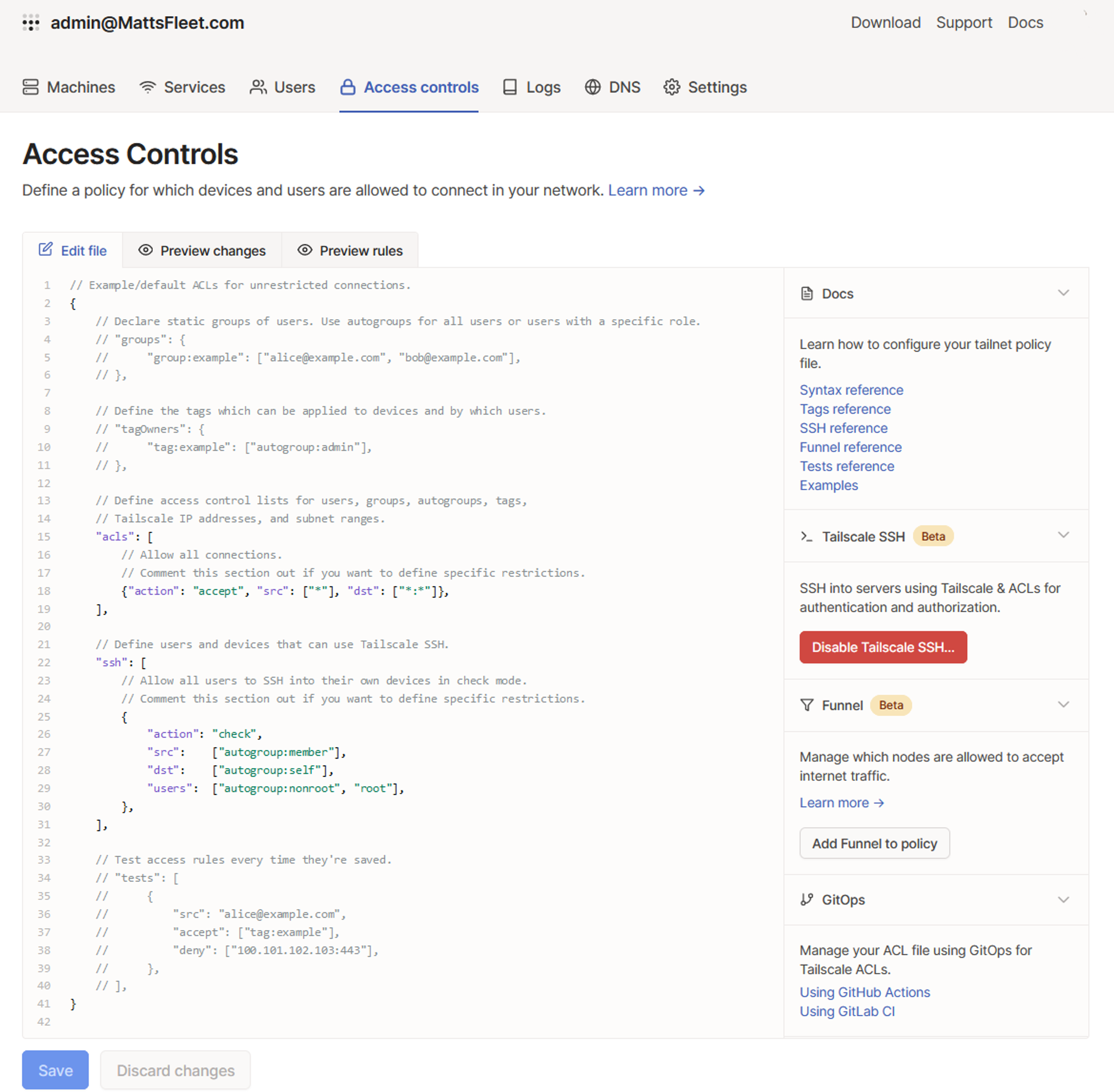Fleet Management: Connectivity, Remote Access, and Network Security
This article explains the limitations of traditional remote connection solutions for fleet management and the need for enhanced network security. It then shows why and how a mesh VPN replacement like Tailscale simplifies securing and scaling networking for your fleet.
Fleet management has progressed far beyond the rudimentary days, where computer systems were merely used to digitize paper records. Today, computing devices like laptops, servers, and IoT sensors all help to maintain real-time communication and tracking for an entire fleet.
For instance, fleet management officers overseeing a bus service might use company laptops to monitor each vehicle’s precise location in real time and communicate with drivers about route changes or updates. At the same time, onboard security cameras capture footage that is transmitted to a centralized server, either in a data center, on-prem, or in the cloud.
Connecting all these components and seamlessly handling high-data workloads such as video all requires streamlined, reliable, and secure network connectivity. Every vehicle in the fleet requires a robust mobile connection to transmit data securely across the internet. You must also ensure that this data in transit remains safe from potential cyber threats.
This article explains the limitations of traditional remote connection solutions for fleet management and the need for enhanced network security. It then shows why and how a mesh VPN replacement like Tailscale simplifies securing and scaling networking for your fleet.
The Challenges of Traditional Networks for Fleet Management
The underlying network infrastructure of a fleet management solution is vitally important to ensure real-time data and constant communication. If you’re simply scaling a traditional network to meet the demands of a modern fleet management solution, you’ll run into some inherent challenges.
Traditional networks with a fixed infrastructure often struggle at scale. Legacy networking solutions simply weren’t built for today’s always-on, mobile, and multi-cloud networking world. Adding new devices or sensors often requires manual configurations, which increases operational overhead and creates the potential for errors. For instance, when a rental car company adds a new batch of cars equipped with IoT devices, it could entail labor-intensive manual configurations that extend operational deadlines and slow the pace of digital transformation for the entire business
As a fleet management network expands, managing and updating security and connectivity tools such as a VPN also becomes increasingly complex. Keeping up with the constant stream of patches and updates to address security vulnerabilities can be daunting, and any oversight can make the entire network susceptible to threats. Keep in mind that a single vulnerability could jeopardize an entire system.
Scaling a traditional network also increases your remote access risks. While remote access tools such as RDP, SSH, or VNC are essential, they can pose significant security risks if not managed with the utmost of care. Without rigorous security protocols, these remote access gateways can inadvertently become entry points for malicious actors, putting your organization’s entire infrastructure at risk.
For example, take a fleet manager remotely accessing a cargo truck terminal to fetch sensitive data over RDP on a public IP address. A cyber attacker could exploit the RDP entrance that’s been created to access logistical data—or even take control of their vehicle systems.
Lastly, scaling traditional networks also lacks granularity. Different roles require different kinds of access. Conventional network setups often lack the sophistication to provide different access levels, which makes it more difficult to ensure that employees access only the data and systems pertinent to their roles.
For instance, a technician might need access to the engine diagnostics of a bus, but they should not have access to the cargo or financial data the vehicle system is holding. Traditional systems might also struggle to differentiate these levels of access seamlessly.
The Benefits of a Mesh-Network VPN Solution
An enterprise-level business VPN replacement service like Tailscale can help secure your fleet operations by offering a simpler network management solution that addresses modern security challenges with features like end-to-end encryption.
Tailscale enables you to quickly and easily create your own “tailnet”—essentially a private network created for your devices that facilitates secure communication across devices irrespective of their location. Underpinned by the robust WireGuardⓇ protocol, Tailscale provides a strong and granularly configurable mesh network that harnesses the speed of a zero-configuration VPN to help you set up secure, lightweight, and reliable connections.
Let’s explore the benefits Tailscale offers for fleet management.
Simplified Setup and Management
Tailscale removes much of the hassle of setting up, scaling, and managing your fleet’s network infrastructure.
Its zero-config VPN uses the WireGuard protocol that offers lightweight VPN tunnels for secure connections. Unlike traditional VPN setups that demand intricate configurations and constant management, WireGuard simplifies many of these processes, and Tailscale makes things even easier with higher levels of automation, speed, and support.
Tailscale’s easy onboarding process takes the hassle out of adding new devices to your network. Instead of sifting through intricate configurations, you simply install the client and authenticate the device to have it appear on your Tailscale admin dashboard.

Tailscale integrates with the major identity providers for single sign-on (SSO) and multi-factor authentication (MFA). This eliminates the need to create new users or identities, ensuring robust access control.

Beyond identity management, Tailscale is designed with broad compatibility in mind. It supports a wide range of systems and operating systems, including Windows, macOS, Linux, iOS, and Android. This universal compatibility ensures comprehensive coverage and security across your entire fleet of devices, no matter the platform.
Tailscale SSH also enables SSH access over your tailnet without additional complexity. It allows you to securely connect to your fleet without exposing IP addresses or ports publicly, which minimizes the risk of an attack on your fleet and your network.
Robust Access Control
Tailscale’s access control lists, ACLs, give you granular control over user access to specific devices and services on your tailnet. You can use groups and tags to ensure that only authorized personnel can access certain segments of your network to enhance both security and operational efficiency.
For instance, while technicians might need access to IoT sensors and the GPS for manual updates and troubleshooting, commercial employees might need to connect to vehicles in the field to send or receive administrative data needed for tasks such as customs clearance. ACLs ensure the right user groups have access to everything they need, without exposing critical business infrastructure.

Enhanced Connectivity, Resilience, and Privacy
Tailscale gives you reliable remote access to devices out in the field while ensuring that your data remains secure.
Establishing a seamless communication link is difficult when devices such as vehicles or remote fleet management stations operate behind different NAT firewalls. A common way to circumvent this problem would be to enable UPnPon firewalls. But administrators rightly hesitate to enable UPnP because of security risks.
Tailscale lets you avoid these issues by using advanced NAT traversal techniques based on the internet STUN and ICE standards. This setup ensures stable connections without resorting to complex firewall configurations or opening public-facing ports.
Fleet management requires reliable and continuous network operations to ensure uninterrupted access to real-time data. Traditional networking solutions often lack robust failover mechanisms, leaving operations vulnerable to potential outages.
Tailscale addresses these challenges by using independently operating coordination servers and globally distributed DERP relay servers to minimize single points of failure. This enhanced resilience ensures that communication between nodes remains constant, even in challenging conditions.
Lastly, in a world where privacy concerns loom large, Tailscale’s open source code is fully auditable. It also prioritizes user privacy by collecting only the essential metadata, primarily concerning private nodes and connections. This ensures that the service operates efficiently without compromising your sensitive information.
Cost-Effectiveness
Tailscale can also significantly reduce the expenses you’d incur with other security solutions.
For example, public cloud providers offer paid features such as just-in-time (JIT) access and bastion. These services are specifically designed to facilitate secure connections to your cloud-based computing resources, like virtual machines, without resorting to risky measures like exposing a public IP. However, they come with a hefty price tag.
With Tailscale, you can achieve the same or even superior security when establishing connections to these cloud resources at a fraction of the cost. Plus, you maintain complete visibility and control over your new private network, without connecting internal resources to the cloud unnecessarily just to facilitate basic connectivity and remote shared access.
Conclusion
Companies with a large number of physical IoT devices in the field—whether they’re vehicles, cell phones, commercial equipment, or the like—struggle with securely connecting these devices and providing remote access to them.
Using traditional networks for these fleet management uses poses several challenges—limited scalability, security and remote access risks, archaic backhaul designs, and a lack of granular access controls.
A zero-configuration mesh VPN replacement solution like Tailscale simplifies your network operations while providing enhanced security, connectivity, and privacy. Tailscale offers simplified onboarding and zero-config VPN setup using the WireGuard protocol, advanced NAT traversal for uninterrupted connections, seamless integration with existing identity providers, and a robust and granular access control mechanism.
Want to try Tailscale? Sign up to try it out for free.






